The Impact of Atmospheric Cadmium Exposure on Colon Cancer and the Invasiveness of Intestinal Stents in the Cancerous Colon
Abstract
1. Introduction
2. Materials and Methods
2.1. Animal and Experimental Design
2.2. Establishment of the Simulation Environment
2.3. In Vivo Imaging
2.4. Histopathology
2.5. Immunohistochemistry
2.6. Western Blot Analysis
2.7. Statistical Analysis
3. Results
3.1. Colon Tumor Invasion and Metastasis Capabilities
3.2. Oxidative Stress
3.3. Inflammation
4. Discussion
5. Conclusions
Supplementary Materials
Author Contributions
Funding
Institutional Review Board Statement
Informed Consent Statement
Data Availability Statement
Conflicts of Interest
References
- Tian, R.; Chen, J.; Niu, R. The development of low-molecular weight hydrogels for applications in cancer therapy. Nanoscale 2022, 6, 3474–3482. [Google Scholar] [CrossRef]
- Lin, X.; Peng, L.; Xu, X.; Chen, Y.; Zhang, Y.; Huo, X. Connecting gastrointestinal cancer risk to cadmium and lead exposure in the Chaoshan population of Southeast China. Environ. Sci. Pollut. Res. 2018, 25, 17611–17619. [Google Scholar] [CrossRef]
- Rinaldi, L.; Barabino, G.; Klein, J.P.; Bitounis, D.; Pourchez, J.; Forest, V.; Boudard, D.; Leclerc, L.; Sarry, G.; Roblin, X.; et al. Metals distribution in colorectal biopsies: New insight on the elemental fingerprint of tumour tissue. Digest. Liver Dis. 2015, 47, 602–607. [Google Scholar] [CrossRef][Green Version]
- Sarkar, S.; Mukherjee, S.K.; Roy, K.; Ghosh, P. Evaluation of Role of Heavy Metals in Causation of Colorectal Cancer. J. Evol. Med. Dent. Sci. 2020, 9, 1036–1039. [Google Scholar] [CrossRef]
- Briffa, J.; Sinagra, E.; Blundell, R. Heavy metal pollution in the environment and their toxicological effects on humans. Heliyon 2020, 6, e04691. [Google Scholar] [CrossRef]
- Rahman, Z.; Singh, V.P. The relative impact of toxic heavy metals (THMs) (arsenic (As), cadmium (Cd), chromium (Cr)(VI), mercury (Hg), and lead (Pb)) on the total environment: An overview. Environ. Monit Assess. 2019, 191, 419. [Google Scholar] [CrossRef]
- Nawrot, T.S.; Martens, D.S.; Hara, A.; Plusquin, M.; Vangronsveld, J.; Roels, H.A.; Staessen, J.A. Association of total cancer and lung cancer with environmental exposure to cadmium: The meta-analytical evidence. Cancer Cause Control 2015, 26, 1281–1288. [Google Scholar] [CrossRef] [PubMed]
- Nishijo, M.; Nakagawa, H.; Suwazono, Y.; Nogawa, K.; Sakurai, M.; Ishizaki, M.; Kido, T. Cancer mortality in residents of the cadmium-polluted Jinzu River basin in Toyama, Japan. Toxics 2018, 6, 23. [Google Scholar] [CrossRef]
- Lin, H.C.; Hao, W.M.; Chu, P.H. Cadmium and cardiovascular disease: An overview of pathophysiology, epidemiology, therapy, and predictive value. Rev. Port. Cardiol. 2021, 40, 611–617. [Google Scholar] [CrossRef]
- Tellez-Plaza, M.; Jones, M.R.; Dominguez-Lucas, A.; Guallar, E.; Navas-Acien, A. Cadmium exposure and clinical cardiovascular disease: A systematic review topical collection on nutrition. Curr. Atheroscler. Rep. 2013, 15, 356. [Google Scholar] [CrossRef] [PubMed]
- Salama, S.A.; Mohamadin, A.M.; Abdel-Bakky, M.S. Arctigenin alleviates cadmium-induced nephrotoxicity: Targeting endoplasmic reticulum stress, Nrf2 signaling, and the associated inflammatory response. Life Sci. 2021, 287, 120121. [Google Scholar] [CrossRef]
- Taş, İ.; Zhou, R.; Park, S.Y.; Yang, Y.; Gamage, C.D.B.; Son, Y.J.; Paik, M.J.; Kim, H. Inflammatory and tumorigenic effects of environmental pollutants found in particulate matter on lung epithelial cells. Toxicol. In Vitro 2019, 59, 300–311. [Google Scholar] [CrossRef]
- Mahmood, M.H.R.; Qayyum, M.A.; Yaseen, F.; Farooq, T.; Farooq, Z.; Yaseen, M.; Irfan, A.; Muddassir, K.; Zafar, M.N.; Qamar, M.T.; et al. Multivariate Investigation of Toxic and Essential Metals in the Serum from Various Types and Stages of Colorectal Cancer Patients. Biol. Trace Elem. Res. 2022, 200, 31–48. [Google Scholar] [CrossRef]
- Lu, J.; Zhou, Z.; Zheng, J.; Zhang, Z.; Lu, R.; Liu, H.; Shi, H.; Tu, Z. 2D-DIGE and MALDI TOF/TOF MS analysis reveal that small GTPase signaling pathways may play an important role in cadmium-induced colon cell malignant transformation. Toxicol. Appl. Pharm. 2015, 288, 106–113. [Google Scholar] [CrossRef] [PubMed]
- Chou, W.C.; Jie, C.; Kenedy, A.A.; Jones, R.J.; Trush, M.A.; Dang, C.V. Role of NADPH oxidase in arsenic-induced reactive oxygen species formation and cytotoxicity in myeloid leukemia cells. Proc. Natl. Acad. Sci. USA 2004, 101, 4578–4583. [Google Scholar] [CrossRef]
- Coant, N.; Ben Mkaddem, S.; Pedruzzi, E.; Guichard, C.; Tréton, X.; Ducroc, R.; Freund, J.-N.; Cazals-Hatem, D.; Bouhnik, Y.; Woerther, P.-L.; et al. NADPH Oxidase 1 Modulates WNT and NOTCH1 Signaling To Control the Fate of Proliferative Progenitor Cells in the Colon. Mol. Cell. Biol. 2010, 30, 2636–2650. [Google Scholar] [CrossRef] [PubMed]
- Yu, M.; Qin, K.; Fan, J.; Zhao, G.; Zhao, P.; Zeng, W.; Chen, C.; Wang, A.; Wang, Y.; Zhong, J.; et al. The evolving roles of Wnt signaling in stem cell proliferation and differentiation, the development of human diseases, and therapeutic opportunities. Genes Dis. 2023, 11, 101026. [Google Scholar] [CrossRef] [PubMed]
- Braunschweig, L.; Meyer, A.K.; Wagenführ, L.; Storch, A. Oxygen regulates proliferation of neural stem cells through Wnt/β-catenin signalling. Mol. Cell. Neurosci. 2015, 67, 84–92. [Google Scholar] [CrossRef] [PubMed]
- Qiu, W.; Chen, L.; Kassem, M. Activation of non-canonical Wnt/JNK pathway by Wnt3a is associated with differentiation fate determination of human bone marrow stromal (mesenchymal) stem cells. Biochem. Biophys. Res. Commun. 2011, 413, 98–104. [Google Scholar] [CrossRef] [PubMed]
- Yadav, R.P.; Baranwal, S. Kindlin-2 regulates colonic cancer stem-like cells survival and self-renewal via Wnt/β-catenin mediated pathway. Cell. Signal. 2024, 113, 110953. [Google Scholar] [CrossRef]
- Jung, Y.S.; Park, J.I. Wnt signaling in cancer: Therapeutic targeting of Wnt signaling beyond β-catenin and the destruction complex. Exp. Mol. Med. 2020, 52, 183–191. [Google Scholar] [CrossRef] [PubMed]
- Li, Y.; Bavarva, J.H.; Wang, Z.; Guo, J.; Qian, C.; Thibodeau, S.N.; Golemis, E.A.; Liu, W. HEF1, a novel target of Wnt signaling, promotes colonic cell migration and cancer progression. Oncogene 2011, 30, 2633–2643. [Google Scholar] [CrossRef]
- Naji, S.; Issa, K.; Eid, A.; Iratni, R.; Eid, A.H. Cadmium induces migration of colon cancer cells: Roles of reactive oxygen species, p38 and cyclooxygenase-2. Cell. Physiol. Biochem. 2019, 52, 1517–1534. [Google Scholar] [CrossRef] [PubMed]
- Mahmoud, A.S.; Umair, A.; Azzeghaiby, S.N.; Hussain, F.; Hanouneh, S.; Tarakji, B. Expression of Cyclooxygenase-2 (COX-2) in Colorectal Adenocarcinoma: An Immunohistochemical and Histopathological Study. Asian Pac. J. Cancer Prev. 2014, 15, 6787–6790. [Google Scholar] [CrossRef][Green Version]
- Peng, L.; Zhou, Y.; Wang, Y.; Mou, H.; Zhao, Q. Prognostic Significance of COX-2 Immunohistochemical Expression in Colorectal Cancer: A Meta-Analysis of the Literature. PLoS ONE 2013, 8, e58891. [Google Scholar] [CrossRef]
- Tatsuguchi, A.; Kishida, T.; Fujimori, S.; Tanaka, S.; Gudis, K.; Shinji, S.; Furukawa, K.; Tajiri, T.; Sugisaki, Y.; Fukuda, Y.; et al. Differential expression of cyclo-oxygenase-2 and nuclear β-catenin in colorectal cancer tissue. Aliment. Pharm. Ther. Symp. Ser. 2006, 2, 153–159. [Google Scholar] [CrossRef]
- Breyer, R.M.; Bagdassarian, C.K.; Myers, S.A.; Breyer, M.D. Prostanoid Receptors: Subtypes and Signaling. Annu. Rev. Pharmacol. Toxicol. 2001, 41, 661–690. [Google Scholar] [CrossRef] [PubMed]
- Waller, R.; Narramore, R.; Simpson, J.E.; Heath, P.R.; Verma, N.; Tinsley, M.; Barnes, J.R.; Haris, H.T.; Henderson, F.E.; Matthews, F.E.; et al. Heterogeneity of cellular inflammatory responses in ageing white matter and relationship to Alzheimer’s and small vessel disease pathologies. Brain Pathol. 2021, 31, e12928. [Google Scholar] [CrossRef]
- Shigeta, K.; Baba, H.; Yamafuji, K.; Kaneda, H.; Katsura, H.; Kubochi, K. Outcomes for Patients with Obstructing Colorectal Cancers Treated with One-Stage Surgery Using Transanal Drainage Tubes. J. Gastrointest. Surg. 2014, 18, 1507–1513. [Google Scholar] [CrossRef]
- Shingu, Y.; Hasegawa, H.; Sakamoto, E.; Komatsu, S.; Kurumiya, Y.; Norimizu, S.; Taguchi, Y. Clinical and oncologic safety of laparoscopic surgery for obstructive left colorectal cancer following transanal endoscopic tube decompression. Surg. Endosc. 2013, 27, 3359–3363. [Google Scholar] [CrossRef]
- Yoshida, S.; Watabe, H.; Isayama, H.; Kogure, H.; Nakai, Y.; Yamamoto, N.; Sasaki, T.; Kawakubo, K.; Hamada, T.; Ito, Y.; et al. Feasibility of a new self-expandable metallic stent for patients with malignant colorectal obstruction. Digest. Endosc. 2013, 25, 160–166. [Google Scholar] [CrossRef]
- Maruthachalam, K.; Lash, G.E.; Shenton, B.K.; Horgan, A.F. Tumour cell dissemination following endoscopic stent insertion. Brit. J. Surg. 2007, 94, 1151–1154. [Google Scholar] [CrossRef]
- Santos, A.; Lopes, C.; Frias, C.; Amorim, I.; Vicente, C.; Gärtner, F.; Matos, A. Immunohistochemical evaluation of MMP-2 and TIMP-2 in canine mammary tumours: A survival study. Vet. J. 2021, 190, 396–402. [Google Scholar] [CrossRef] [PubMed]
- Lee, T.H.; Chen, J.L.; Liu, P.S.; Tsai, M.M.; Tsai, M.M.; Wang, S.J.; Hsieh, H.L.; Hsieh, H.L. Rottlerin, a natural polyphenol compound, inhibits upregulation of matrix metalloproteinase-9 and brain astrocytic migration by reducing PKC-δ-dependent ROS signal. J. Neuroinflamm. 2020, 17, 177. [Google Scholar] [CrossRef]
- Bláhová, L.; Janoš, T.; Mustieles, V.; Rodríguez-Carrillo, A.; Fernández, M.F.; Bláha, L. Rapid extraction and analysis of oxidative stress and DNA damage biomarker 8-hydroxy-2′-deoxyguanosine (8-OHdG) in urine: Application to a study with pregnant women. Int. J. Hyg. Environ. Health 2023, 250, 114175. [Google Scholar] [CrossRef] [PubMed]
- Xie, J.X.; Xi, Y.; Zhang, Q.L.; Lai, K.F.; Zhong, N.S. Impact of short term forced oral breathing induced by nasal occlusion on respiratory function in mice. Respir. Physiol. Neurobiol. 2015, 205, 37–41. [Google Scholar] [CrossRef] [PubMed]
- Jaques, P.A.; Kim, C.S. Measurement of total lung deposition of inhaled ultrafine particles in healthy men and women. Inhal. Toxicol. 2000, 12, 715–731. [Google Scholar] [CrossRef] [PubMed]
- Wang, L.; Wise, J.T.F.; Zhang, Z.; Shi, X. Progress and Prospects of Reactive Oxygen Species in Metal Carcinogenesis. Curr. Pharm. Rep. 2016, 2, 178–186. [Google Scholar] [CrossRef] [PubMed]
- Chocry, M.; Leloup, L.; Kovacic, H. Progress and Prospects of Reversion of resistance to oxaliplatin by inhibition of p38 MAPK in colorectal cancer cell lines: Involvement of the calpain/Nox1 pathway. Oncotarget 2017, 8, 103710–103730. [Google Scholar] [CrossRef] [PubMed]
- Skrzycki, M.; Czeczot, H.; Chrzanowska, A.; Otto-Ślusarczyk, D. The level of superoxide dismutase expression in primary and metastatic colorectal cancer cells in hypoxia and tissue normoxia. Pol. Merkur. Lek. 2015, 39, 281–286. [Google Scholar]
- Tang, Z.; Meng, S.Y.; Yang, X.X.; Xiao, Y.; Wang, W.T.; Liu, Y.H.; Wu, K.F.; Zhang, X.C.; Guo, H.; Zhu, Y.Z.; et al. Neutrophil-Mimetic, ROS Responsive, and Oxygen Generating Nanovesicles for Targeted Interventions of Refractory Rheumatoid Arthritis. Small 2023, 2307379. [Google Scholar] [CrossRef]
- Zhang, X.; Li, C.; Wu, Y.; Cui, P. The research progress of Wnt/β-catenin signaling pathway in colorectal cancer. Clin. Res. Hepatol. Gastroenterol. 2023, 47, 102086. [Google Scholar] [CrossRef] [PubMed]
- DU, J. Association between shortage of energy supply and nuclear gene mutations leading to carcinomatous transformation. Mol. Clin. Oncol. 2016, 4, 11–12. [Google Scholar] [CrossRef] [PubMed][Green Version]
- Wei, Z.; Shaikh, Z.A. Cadmium stimulates metastasis-associated phenotype in triple-negative breast cancer cells through integrin and β-catenin signaling. Toxicol. Appl. Pharm. 2017, 328, 70–80. [Google Scholar] [CrossRef] [PubMed]
- Chakraborty, P.K.; Scharner, B.; Jurasovic, J.; Messner, B.; Bernhard, D.; Thévenod, F. Chronic cadmium exposure induces transcriptional activation of the Wnt pathway and upregulation of epithelial-to-mesenchymal transition markers in mouse kidney. Toxicol. Lett. 2010, 198, 69–76. [Google Scholar] [CrossRef] [PubMed]
- Wang, Y.; Shi, L.; Li, J.; Li, L.; Wang, H.; Yang, H. Long-term cadmium exposure promoted breast cancer cell migration and invasion by up-regulating TGIF. Ecotoxicol. Environ. Saf. 2019, 175, 110–117. [Google Scholar] [CrossRef]
- Feng, Y.; Chen, Y.; Chen, Y.; He, X.; Khan, Y.; Hu, H.; Lan, P.; Li, Y.; Wang, X.; Li, G.; et al. Intestinal stents: Structure, functionalization and advanced engineering innovation. Biomater. Adv. 2022, 137, 212810. [Google Scholar] [CrossRef]
- Matsuda, A.; Miyashita, M.; Matsumoto, S.; Sakurazawa, N.; Kawano, Y.; Yamahatsu, K.; Sekiguchi, K.; Yamada, M.; Hatori, T.; Yoshida, H. Colonic stent-induced mechanical compression may suppress cancer cell proliferation in malignant large bowel obstruction. Surg. Endosc. 2019, 33, 1290–1297. [Google Scholar] [CrossRef]
- Choi, S.J.; Min, J.W.; Yun, J.M.; Ahn, H.S.; Han, D.J.; Lee, H.J.; Kim, Y.O. Portal vein thrombosis with sepsis caused by inflammation at colonic stent insertion site. Korean J. Gastroenterol. 2015, 65, 316–320. [Google Scholar] [CrossRef][Green Version]
- Nilsson, R.; Liu, N.A. Nuclear DNA damages generated by reactive oxygen molecules (ROS) under oxidative stress and their relevance to human cancers, including ionizing radiation-induced neoplasia part I: Physical, chemical and molecular biology aspects. Radiat. Med. Prot. 2020, 1, 140–152. [Google Scholar] [CrossRef]
- Kajla, S.; Mondol, A.S.; Nagasawa, A.; Zhang, Y.; Kato, M.; Matsuno, K.; Yabe-Nishimura, C.; Kamata, T. A crucial role for Nox 1 in redox-dependent regulation of Wnt-β-catenin signaling. FASEB J. 2012, 26, 2049–2059. [Google Scholar] [CrossRef]
- Wang, X.; Mandal, A.K.; Saito, H.; Pulliam, J.F.; Lee, E.Y.; Ke, Z.J.; Lu, J.; Ding, S.; Li, L.; Shelton, B.J.; et al. Arsenic and chromium in drinking water promote tumorigenesis in a mouse colitis-associated colorectal cancer model and the potential mechanism is ROS-mediated Wnt/β-catenin signaling pathway. Toxicol. Appl. Pharm. 2012, 262, 11–21. [Google Scholar] [CrossRef]
- Zhang, Z.; Wang, X.; Cheng, S.; Sun, L.; Son, Y.O.; Yao, H.; Li, W.; Budhraja, A.; Li, L.; Shelton, B.J.; et al. Reactive oxygen species mediate arsenic induced cell transformation and tumorigenesis through Wnt/β-catenin pathway in human colorectal adenocarcinoma DLD1 cells. Toxicol. Appl. Pharm. 2011, 256, 114–121. [Google Scholar] [CrossRef]
- Tyagi, A.; Chandrasekaran, B.; Navin, A.K.; Shukla, V.; Baby, B.V.; Ankem, M.K.; Damodaran, C. Molecular interplay between NOX1 and autophagy in cadmium-induced prostate carcinogenesis. Free Radical. Biol. Med. 2023, 199, 44–55. [Google Scholar] [CrossRef]
- Lian, S.; Xia, Y.; Khoi, P.N.; Ung, T.T.; Yoon, H.J.; Kim, N.H.; Kim, K.K.; Jung, Y.D. Cadmium induces matrix metalloproteinase-9 expression via ROS-dependent EGFR, NF-κB, and AP-1 pathways in human endothelial cells. Toxicology 2015, 338, 104–116. [Google Scholar] [CrossRef]
- Zelko, I.N.; Mariani, T.J.; Folz, R.J. Superoxide dismutase multigene family: A comparison of the CuZn-SOD (SOD1), Mn-SOD (SOD2), and EC-SOD (SOD3) gene structures, evolution, and expression. Free Radical. Biol. Med. 2002, 33, 337–349. [Google Scholar] [CrossRef]
- Picazo, C.; Padilla, C.A.; McDonagh, B.; Matallana, E.; Bárcena, J.A.; Aranda, A. Regulation of metabolism, stress response, and sod1 activity by cytosolic thioredoxins in yeast depends on growth phase. Adv. Redox. Res. 2023, 9, 100081. [Google Scholar] [CrossRef]
- Miar, A.; Hevia, D.; Muñoz-Cimadevilla, H.; Astudillo, A.; Velasco, J.; Sainz, R.M.; Mayo, J.C. Manganese superoxide dismutase (SOD2/MnSOD)/catalase and SOD2/GPx1 ratios as biomarkers for tumor progression and metastasis in prostate, colon, and lung cancer. Free Radical. Biol. Med. 2015, 85, 45–55. [Google Scholar] [CrossRef]
- Ighodaro, O.M.; Akinloye, O.A. First line defence antioxidants-superoxide dismutase (SOD), catalase (CAT) and glutathione peroxidase (GPX): Their fundamental role in the entire antioxidant defence grid. Alex. J. Med. 2018, 54, 287–293. [Google Scholar] [CrossRef]
- Shah, R.; Ibis, B.; Kashyap, M.; Boussiotis, V.A. The role of ROS in tumor infiltrating immune cells and cancer immunotherapy. Metabolism 2024, 151, 155747. [Google Scholar] [CrossRef]
- Yang, J.Y.; Wang, J.; Hu, Y.; Shen, D.Y.; Xiao, G.L.; Qin, X.Y.; Lan, R.F. Paeoniflorin improves cognitive dysfunction, restores glutamate receptors, attenuates gliosis and maintains synaptic plasticity in cadmiumintoxicated mice. Arab. J. Chem. 2023, 16, 104406. [Google Scholar] [CrossRef]

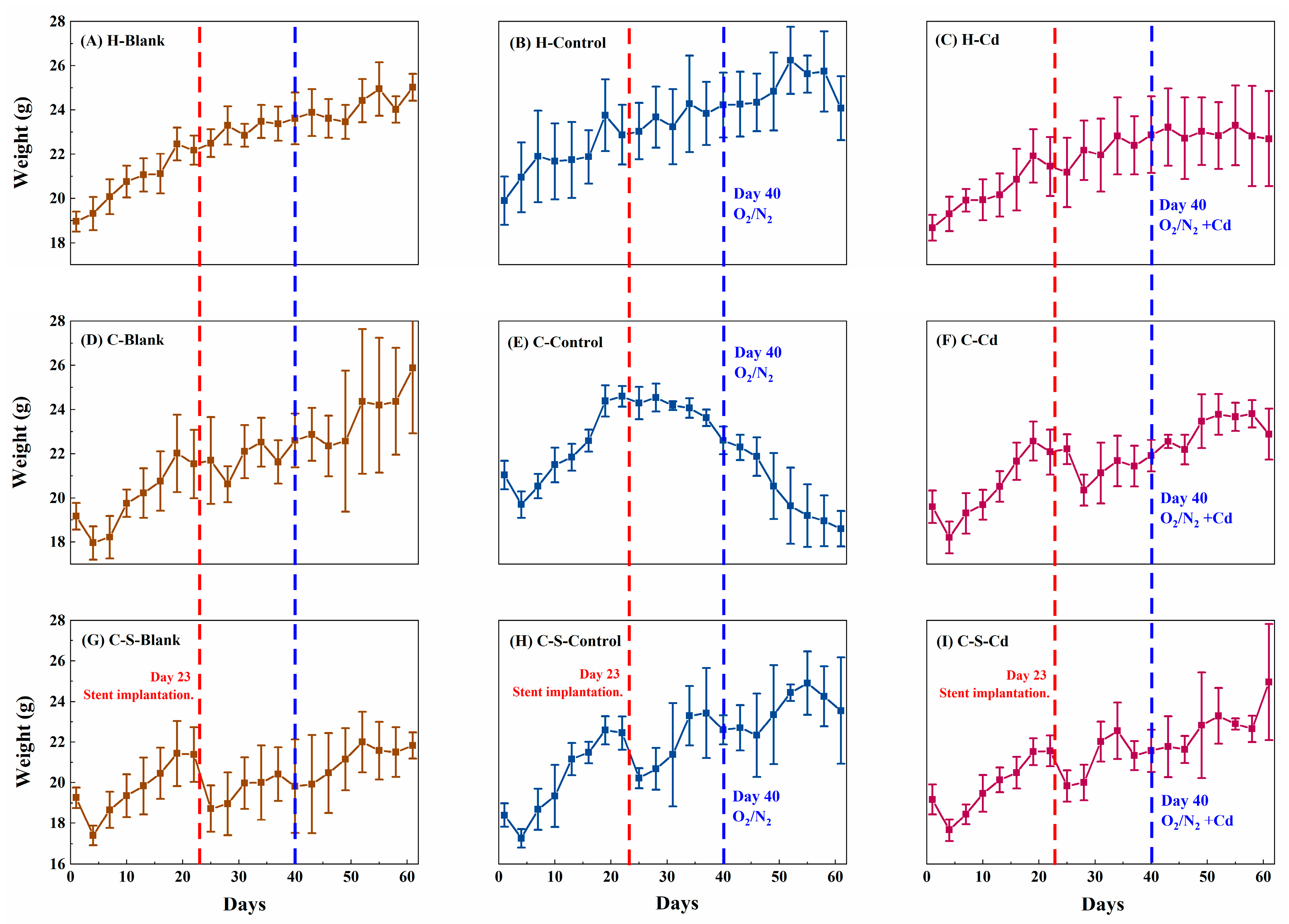
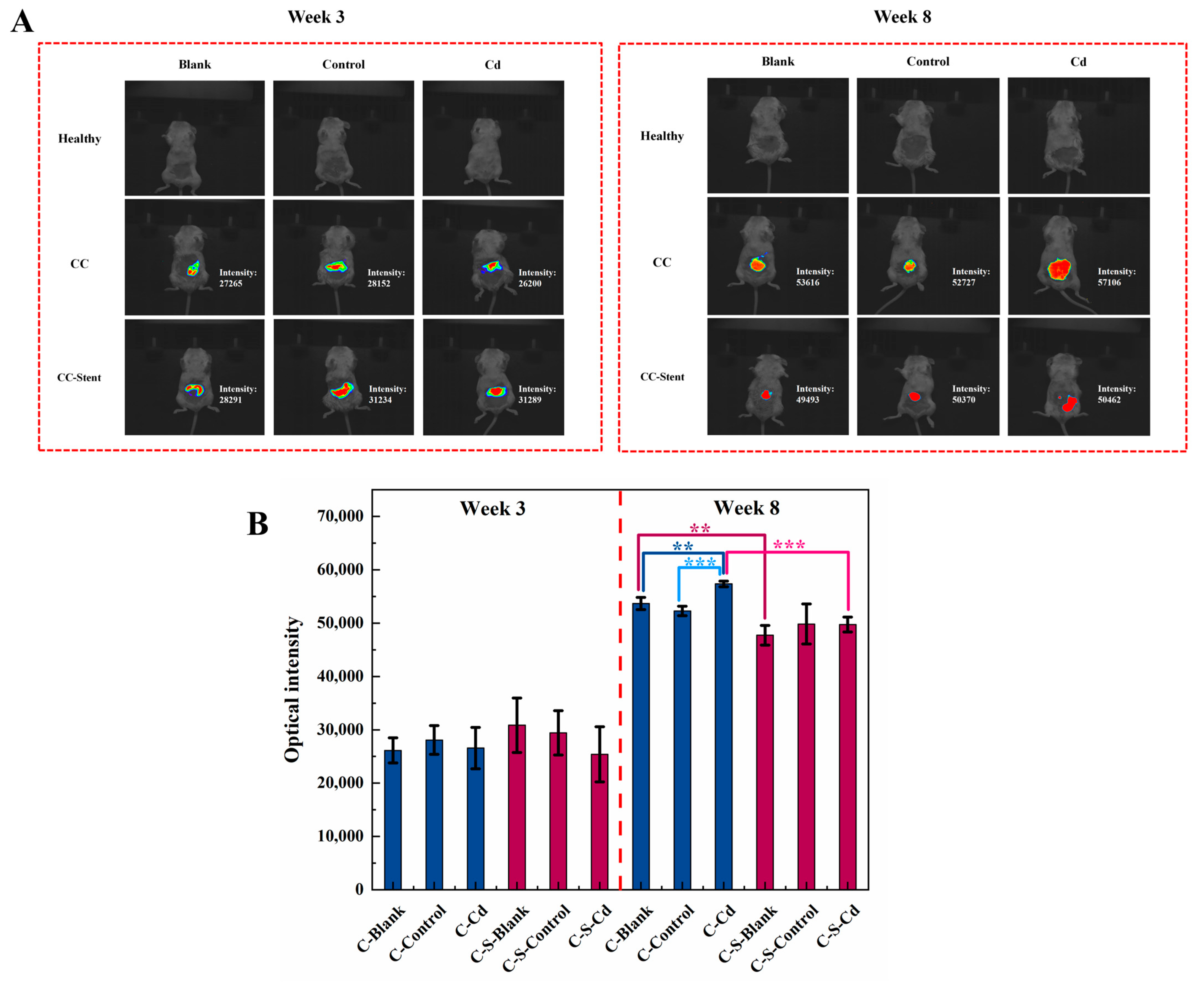
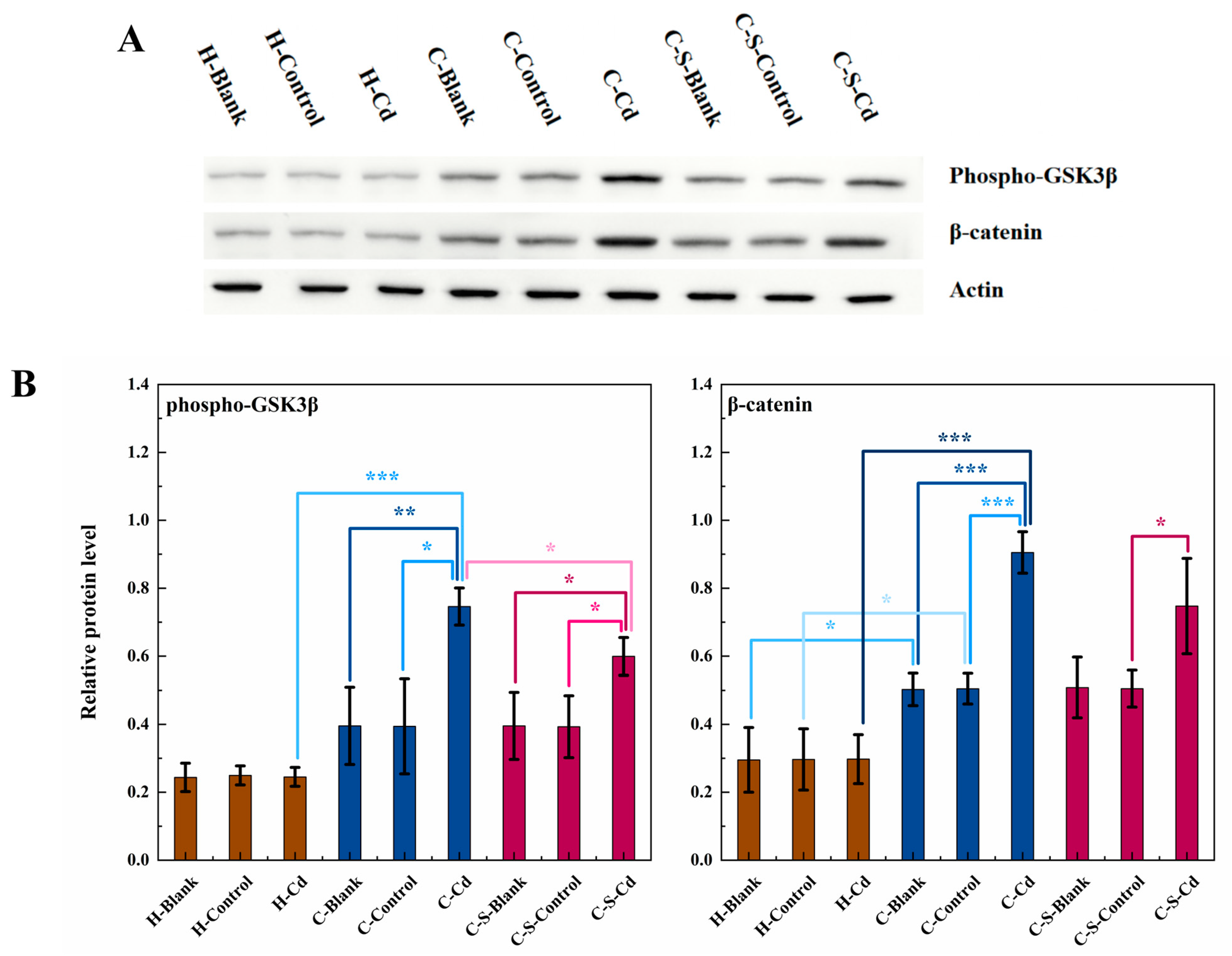

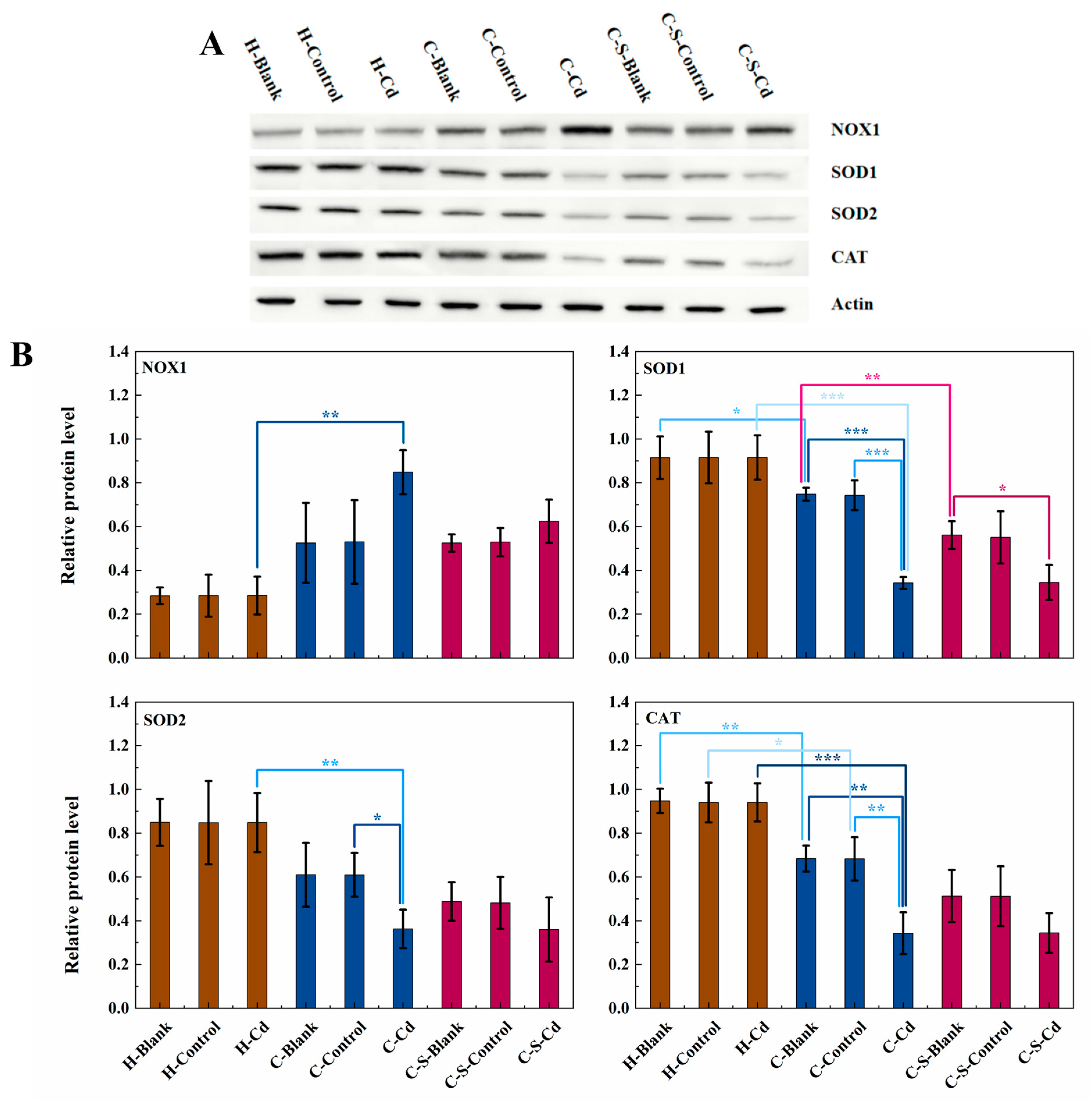
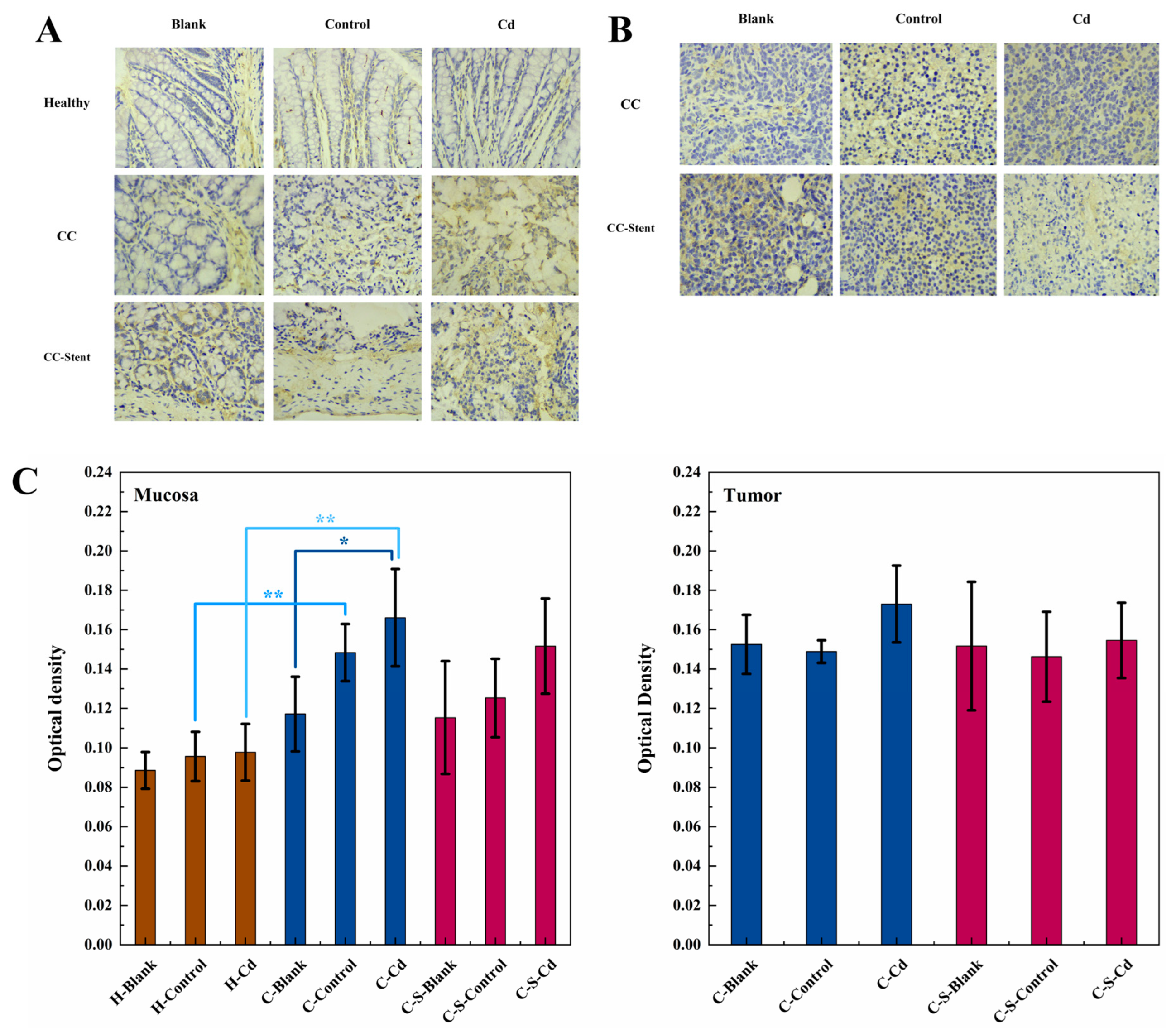
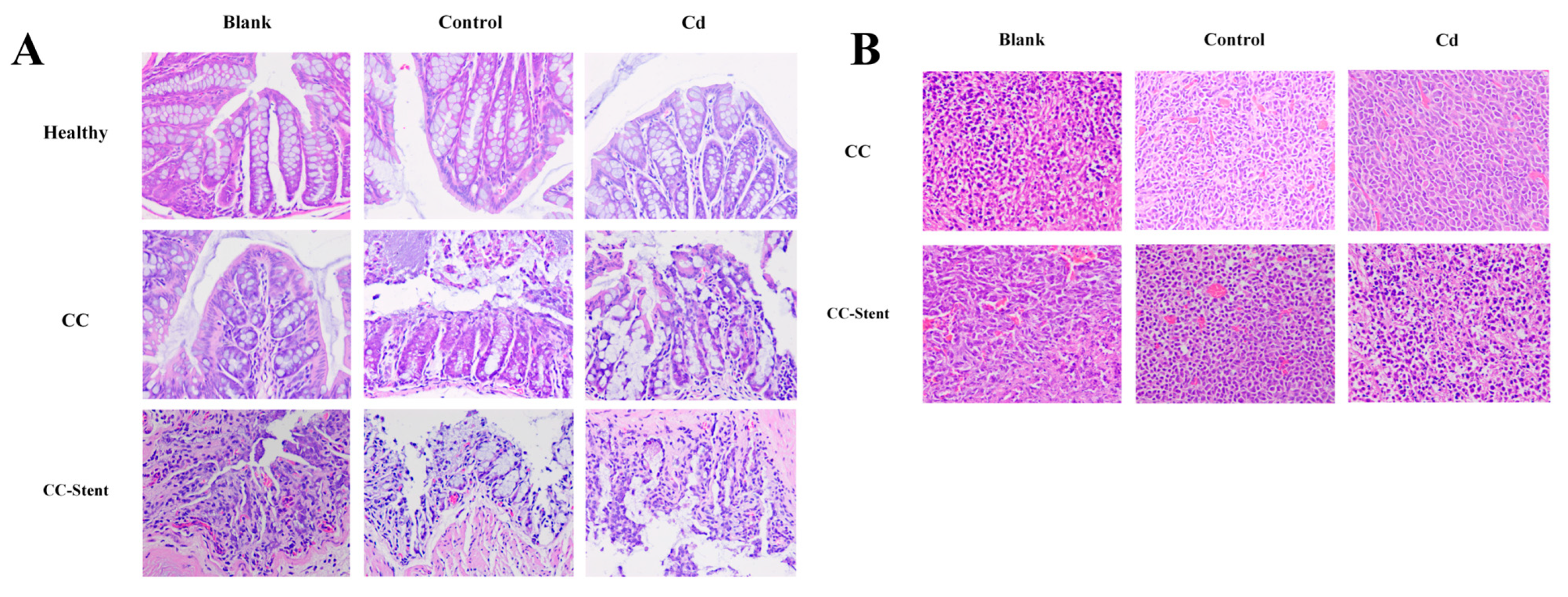
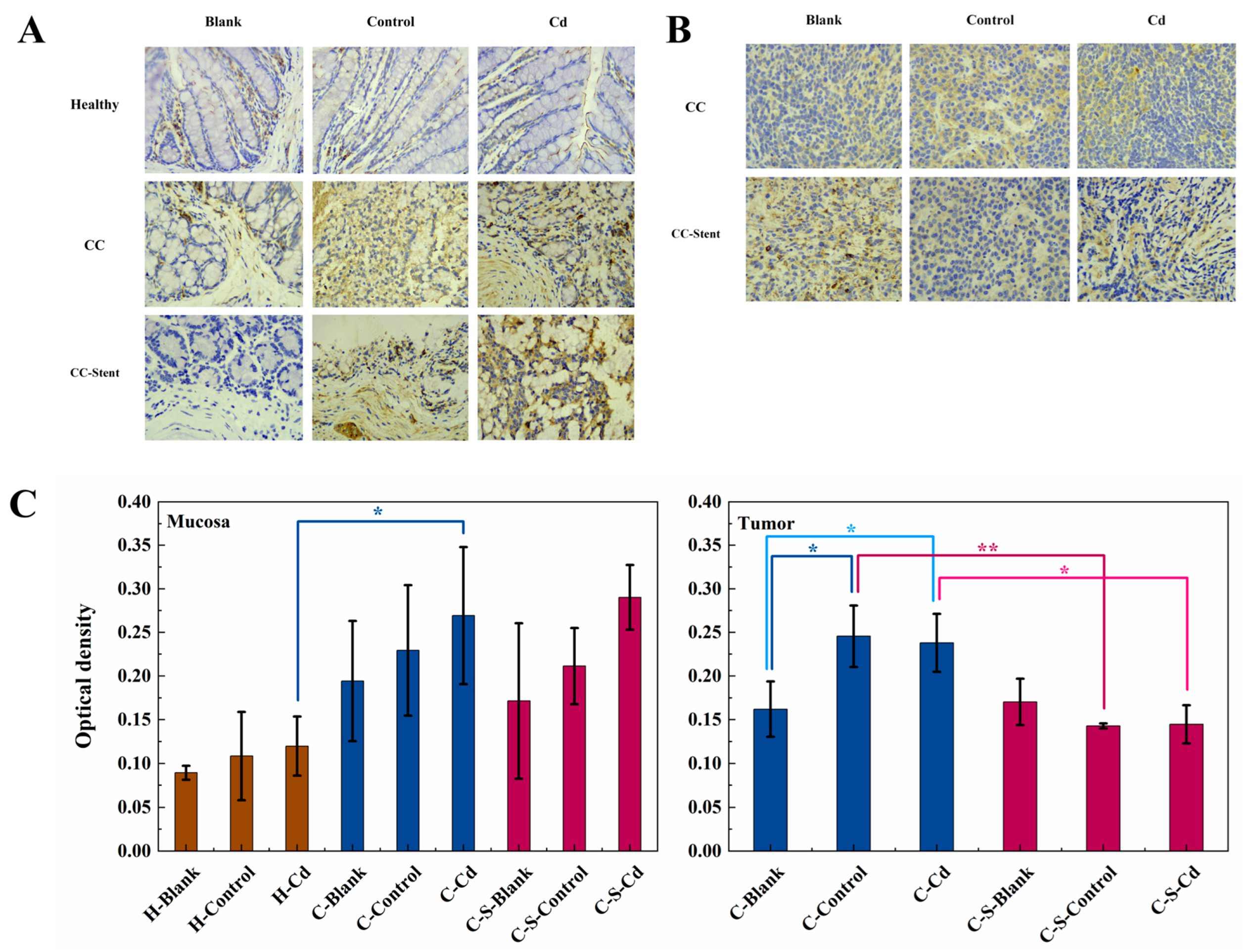
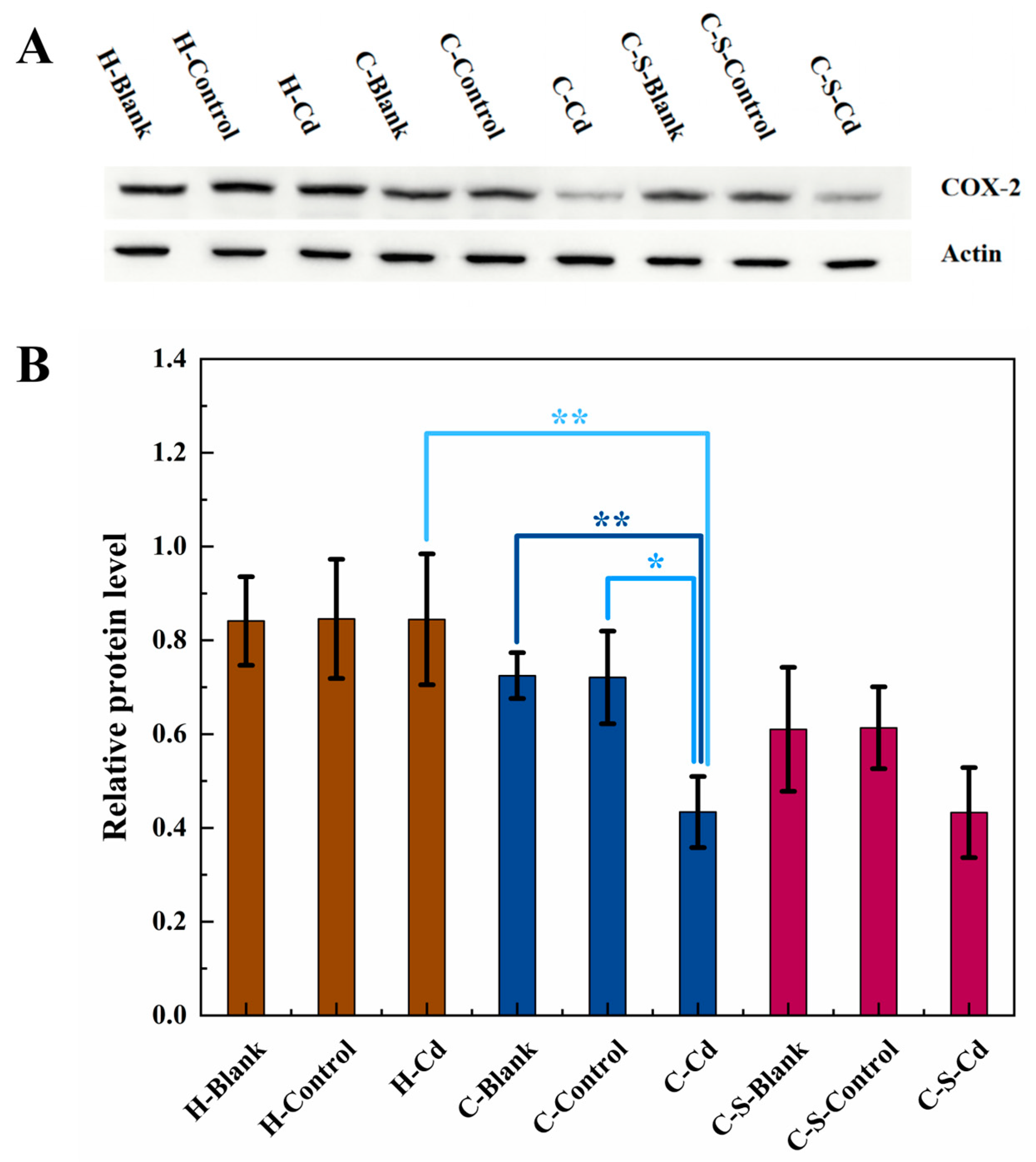

Disclaimer/Publisher’s Note: The statements, opinions and data contained in all publications are solely those of the individual author(s) and contributor(s) and not of MDPI and/or the editor(s). MDPI and/or the editor(s) disclaim responsibility for any injury to people or property resulting from any ideas, methods, instructions or products referred to in the content. |
© 2024 by the authors. Licensee MDPI, Basel, Switzerland. This article is an open access article distributed under the terms and conditions of the Creative Commons Attribution (CC BY) license (https://creativecommons.org/licenses/by/4.0/).
Share and Cite
Zhang, S.; Li, R.; Xu, J.; Liu, Y.; Zhang, Y. The Impact of Atmospheric Cadmium Exposure on Colon Cancer and the Invasiveness of Intestinal Stents in the Cancerous Colon. Toxics 2024, 12, 215. https://doi.org/10.3390/toxics12030215
Zhang S, Li R, Xu J, Liu Y, Zhang Y. The Impact of Atmospheric Cadmium Exposure on Colon Cancer and the Invasiveness of Intestinal Stents in the Cancerous Colon. Toxics. 2024; 12(3):215. https://doi.org/10.3390/toxics12030215
Chicago/Turabian StyleZhang, Shuai, Ruikang Li, Jing Xu, Yan Liu, and Yanjie Zhang. 2024. "The Impact of Atmospheric Cadmium Exposure on Colon Cancer and the Invasiveness of Intestinal Stents in the Cancerous Colon" Toxics 12, no. 3: 215. https://doi.org/10.3390/toxics12030215
APA StyleZhang, S., Li, R., Xu, J., Liu, Y., & Zhang, Y. (2024). The Impact of Atmospheric Cadmium Exposure on Colon Cancer and the Invasiveness of Intestinal Stents in the Cancerous Colon. Toxics, 12(3), 215. https://doi.org/10.3390/toxics12030215






